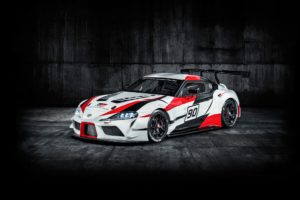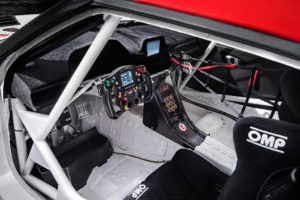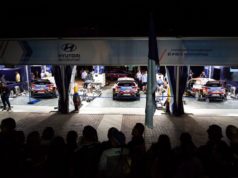The GR Supra Racing Concept makes its world debut at the Geneva Motor Show, reviving the name and spirit of the most celebrated model in Toyota’s illustrious sportscar heritage. It also demonstrates Toyota’s commitment to bringing the Supra back to the market. It also shows the future potential for a car that can deliver high performance both on road and track.
 The GR Supra Racing Concept revives the great heritage of one of Toyota’s most famous sports cars
The GR Supra Racing Concept revives the great heritage of one of Toyota’s most famous sports cars
The Supra name evokes power, performance and handling that defined a succession of world-class cars for a quarter of a century. As a thoroughbred sports car, the Toyota Supra built a reputation as a formidable performer on the road. It also had a reputation as an all-conquering machine on the racetrack. The car dominated Japan’s top-level GT racing series and earned legions of fans.
The Toyota Supra still enjoys an iconic status among sports car aficionados, 16 years from the end of production. Its enduring popularity has been helped by its success as a popular model in the Gran Turismo driving simulator video game. It also was a star in the first film in The Fast and the Furious global action movie series.
The Supra badge first appeared in 1978 on a larger and more powerful version of the second generation Celica before becoming established as a successful model in its own right.
Three further generations followed the original Supra, known as the A40. Those were the A60 in 1981, A70 in 1986 and A80 in 1993.
The front engine/rear-wheel drive GT sportscar remained in production until 2002. And in its final generation, it was Toyota’s most powerful production model.
The Supra’s reputation was greatly enhanced by its success in motorsport. Most notably, the fourth generation Supra, introduced in 1993, became the dominant force in the All-Japan GT racing – today’s Super GT series – winning the GT500 class four times.
The Toyota Supra also competed in American IMSA sportscar racing in the 1980s and twice appeared at Le Mans in the 1990s.
 GR Supra Racing Concept
GR Supra Racing Concept
A compact, two-door car, the GR Supra Racing Concept has a pure front-engine/rear-wheel drive configuration and makes use of advanced lightweight materials in its construction.
Created by Toyota Gazoo Racing, the concept perfectly expresses the “fun to drive” quality that is intrinsic to Toyota’s commitment to making ever-better cars. The large “90” race number on its doors is a historical reference to Supra’s codename. And it is a big visual clue to the fact that this concept heralds Supra’s return in a fifth generation.
Kiichiro Toyoda, the founder of the car company, believed that participation in motorsport provides the challenges of performance and durability that can directly help develop better cars. The new concept’s development is true to that belief.
This ethos has been fully embraced by both Toyota Motor Corporation President Akio Toyoda and by Toyota Gazoo Racing. The team pursues success at the highest levels of international motorsport, including the World Rally Championship, World Endurance Championship and the 24 Hours of Le Mans. Taking part in these and other racing series around the world provides technical learnings that can be transferred from the race track or rally stage to development of not just new generations of Toyota’s sports-focused GR models, but also to its wider range of vehicles, driven by tens of millions of people around the world.
The GR Supra Racing Concept will appear in a new update of the Gran Turismo Sport video game. The game is one of the most popular in the world. It is developed by Polyphony Digital Inc. and scheduled for release in April 2018.
 Design, chassis and equipment features
Design, chassis and equipment features
The racing concept has a dramatic bodywork design that includes a large rear wing. It makes extensive use of strong but lightweight composite material for elements such as the wide front and rear bumpers, front splitter and rear diffuser, side skirts, door mirror housings and the rear wing. The hood is of the same material and features louvred air inlets. The windscreen and side windows are plastic.
The concept’s chassis features lowered front and rear suspension using original equipment (OE) components. The Michelin racing tyres are with BBS racing wheels with centre-nut attachment. The braking system uses Brembo Racing callipers and discs and there is a racing exhaust.
The cabin has a racing dashboard, an OMP driver’s seat and safety harness. OMP has also supplied the quick-release steering wheel, mounted on a racing column and equipped with a paddle shift system. Carbon fibre panels line the doors and the dashboard includes a racing display.
Competition safety requirements are met by a full roll cage and fire extinguishers, and the fuel and brake lines, pedal box, battery and wiring looms are all designed to competition standard.
































